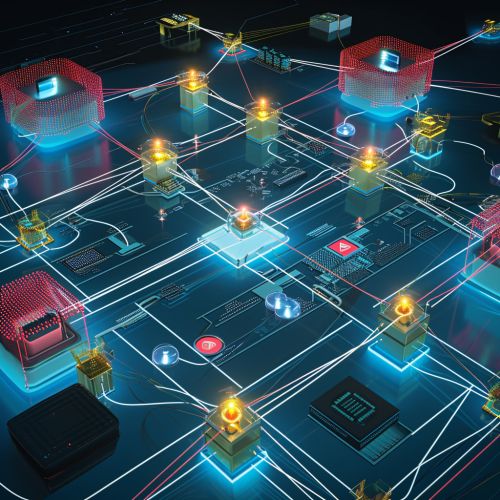Quantum Network
Introduction
A quantum network is a system of interconnected quantum computers, quantum repeaters, and quantum transmitters that use quantum states and quantum entanglement to transmit and process information. These networks offer significant advantages over traditional networks, including enhanced security and computational power.


Quantum Information Theory
At the heart of quantum networks is quantum information theory, a branch of science that studies how information can be manipulated and processed using quantum systems. This theory is a combination of quantum mechanics, information theory, and computer science. It provides the theoretical foundation for quantum networks, quantum computing, and quantum cryptography.
Components of a Quantum Network
Quantum Computers
Quantum computers are the primary nodes in a quantum network. Unlike classical computers that use bits to process information, quantum computers use quantum bits, or qubits. Qubits can exist in a superposition of states, allowing them to process a vast amount of information simultaneously.
Quantum Repeaters
Quantum repeaters are devices that extend the range of quantum communication. They use a process called quantum teleportation to transfer quantum states from one location to another without physically transmitting the quantum particle itself.
Quantum Transmitters
Quantum transmitters are devices that generate and send quantum states over a communication channel. They are essential for establishing quantum key distribution, a secure communication method that uses quantum mechanics to encrypt and decrypt messages.
Quantum Communication
Quantum communication is the process of transmitting quantum states between quantum devices. It is the backbone of a quantum network, enabling secure and efficient data transfer. The primary methods of quantum communication include quantum teleportation and quantum key distribution.
Quantum Network Protocols
Quantum network protocols are rules that govern how quantum devices communicate and interact. These protocols are designed to maximize the unique properties of quantum mechanics, such as superposition and entanglement, to achieve secure and efficient communication.
Quantum Network Security
One of the main advantages of quantum networks is their potential for unparalleled security. The principles of quantum mechanics make it possible to detect any attempt to intercept or tamper with the information being transmitted, providing a level of security that is not possible with classical networks.
Future of Quantum Networks
Quantum networks hold great promise for the future. They could revolutionize fields such as cryptography, computing, and communication, providing secure, fast, and efficient data processing and transmission. However, there are still many challenges to overcome before quantum networks become a reality, including technical hurdles, resource limitations, and the need for further research and development.
